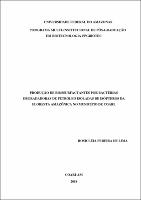| ???jsp.display-item.social.title??? |


|
Please use this identifier to cite or link to this item:
https://tede.ufam.edu.br/handle/tede/6715| ???metadata.dc.type???: | Dissertação |
| Title: | Produção de Biossurfactantes por bactérias degradadoras de petróleo isoladas de isópteros da Floresta Amazônica no município de Coari |
| ???metadata.dc.creator???: | Lima, Rosicléia Pereira de  |
| ???metadata.dc.contributor.advisor1???: | Andrade, Edmar Vaz de |
| First advisor-co: | Costa, Josemar Gurgel de |
| ???metadata.dc.description.resumo???: | A presente dissertação relaciona isópteros da floresta amazônica, petróleo e biossurfactantes. Os isópteros foram alvo desta investigação por viverem em associação a inúmeros microrganismos como bactérias, protozoários flagelados dentre outros que conferem a eles a incrível habilidade em degradar material ligno-celulósico presente em sua principal dieta alimentar: a madeira. A lignina e o petróleo possuem estrutura química composta por anéis aromáticos ou seja os HPAs que conferem a estes compostos recalcitrância e resistência a biodegradação. Microrganismos biodegradadores de petróleo possuem algumas habilidades que facilitam o processo de biodegradação, e uma das estratégias utilizadas é a liberação no meio extracelular de biossurfactantes, que atuam reduzindo à tensão superficial e interfacial das moléculas ocasionando desta forma a biodegradação de compostos hidrofóbicos. Cupins foram coletados na cidade de Coari, de habitat solo e árvore seguindo para o cultivo de consórcio produtor de biossurfactante em meio mínimo e petróleo como única fonte de carbono, posteriormente os microrganismos pertencentes ao consórcio selecionado foram cultivados individualmente, e o microrganismo com maior potencial foi identificado pelo sequenciamento do gene RNA ribossomal 16 S revelando a bactéria Psychrobacillus psychrodurans. Testes realizados como Atividade Emulsificante e Hidrofobicidade Celular revelaram através de análise estatística diferenças significativas nos experimentos envolvendo os solventes Hexano, xileno e petróleo em sete dias de cultivo. No teste de detecção de produção de biossurfactante (colapso de gota) a gota formada pelo sobrenadante livre de células evidenciou a produção de biossurfactante de 0,1 % comparado ao surfactante SDS. A redução da tensão superficial através do método do anel de Du Noyu em tensiometro Kruss foi comprovada utilizando o sobrenadante bacteriano em tempos de cultivo distintos 1, 7 e 12 dias, e apontaram a redução da tensão superficial de 72 mN∕m² para aproximadamente 54,6 mN∕m² em sete dias de cultivo. |
| Abstract: | The present dissertation relates isoptera of the Amazonian forest, oil and biosurfactants. The isoptera were the target of this investigation because they live in association with innumerous microorganisms such as bacteria, flagellated protozoa among others that give them the incredible ability to degrade ligno-cellulosic material present in their main diet: wood. Lignin and petroleum have a chemical structure composed of aromatic rings, ie the PAHs that give these compounds recalcitrance and resistance to biodegradation. Biodegradable petroleum microorganisms have some abilities that facilitate the biodegradation process, and one of the strategies used is the release into the extracellular environment of biosurfactants, which act to reduce the surface and interfacial tension of the molecules, thus causing the biodegradation of hydrophobic compounds. Termites were collected in the city of Coari, from soil habitat and tree followed for the cultivation of consortium producing biosurfactant in minimal medium and oil as the only source of carbon, later the microorganisms belonging to the selected consortium were grown individually, and the microorganism with the highest potential was identified by the sequencing of the 16 S ribosomal RNA gene revealing the bacterium Psychrobacillus psychrodurans. Tests performed as Emulsifying Activity and Cell Hydrophobicity revealed statistical differences in the experiments involving Hexane, xylene and petroleum solvents in seven days of culture. In the detection test of biosurfactant production (droplet collapse) the drop formed by the cell-free supernatant evidenced the production of biosurfactant of 0.1% compared to the SDS surfactant. The reduction of the surface tension by the Du Noyu ring method in Kruss tensiometer was demonstrated using the bacterial supernatant at distinct cultivation times 1, 7 and 12 days and indicated a reduction of the surface tension of 72 mN / m² to approximately 54, 6 mN / m² in seven days of cultivation. |
| Keywords: | Biossurfactantes Isópteros Biologia dos Cupins Diagnose Hábitos Alimentares Morfologia |
| ???metadata.dc.subject.cnpq???: | CIÊNCIAS BIOLÓGICAS |
| Language: | por |
| ???metadata.dc.publisher.country???: | Brasil |
| Publisher: | Universidade Federal do Amazonas |
| ???metadata.dc.publisher.initials???: | UFAM |
| ???metadata.dc.publisher.department???: | Instituto de Ciências Biológicas |
| ???metadata.dc.publisher.program???: | Programa de Pós-Graduação em Biotecnologia |
| Citation: | LIMA, Rosicléia Pereira de. Produção de Biossurfactantes por bactérias degradadoras de petróleo isoladas de isópteros da Floresta Amazônica no município de Coari. 2017. 91 f. Dissertação (Mestrado em Biotecnologia) -Universidade Federal do Amazonas, Coari-AM, 2017. |
| ???metadata.dc.rights???: | Acesso Aberto |
| ???metadata.dc.rights.uri???: | http://creativecommons.org/licenses/by-nc-nd/4.0/ |
| URI: | https://tede.ufam.edu.br/handle/tede/6715 |
| Issue Date: | 20-Dec-2017 |
| Appears in Collections: | Mestrado em Biotecnologia |
Files in This Item:
| File | Description | Size | Format | |
|---|---|---|---|---|
| Dissertação_RosicleiaLima_PPGBIOTEC | 2.75 MB | Adobe PDF |  Download/Open Preview |
This item is licensed under a Creative Commons License





